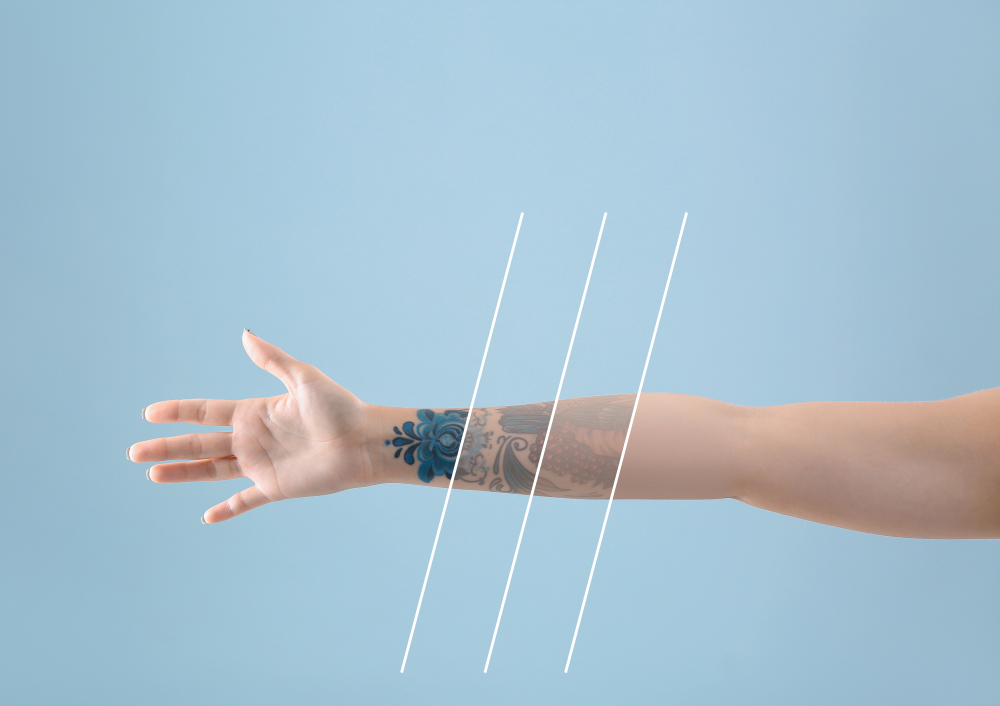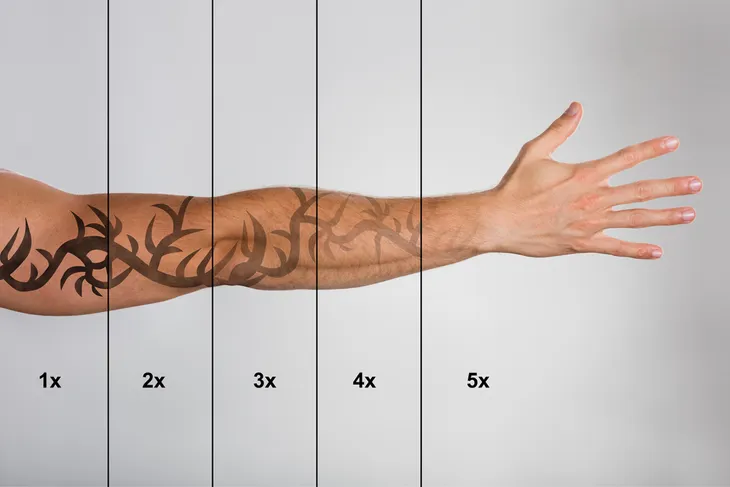- Although tattoos are meant to be permanent there are ways to remove them.
- Popular procedures include laser removal, dermabrasion, chemical peel, and surgical removal.
- Work with a reputable and trained professional to determine which method is best for you.
Tattoos are very popular and everyone gets them for different reasons, from marking a monumental moment like the birth of a child or self-expression. But other times, people deeply regret getting their tattoos. Luckily, there are ways to remove them.
If you’re thinking about tattoo removal there’s a lot to consider. For starters, there are different methods, each with its own procedure, risks, and recovery. So it’s a good idea to weigh your options. Here’s what you need to know about tattoo removal, including the different methods, what to expect, how to prepare, and what the recovery process looks like.
Reasons People Get Their Tattoos Removed
There are many reasons why people want to get their tattoos removed. Some of the most common are either they’re unhappy with the appearance of the tattoo or they simply regret getting it in the first place. It’s possible for tattoos to fade or become blurry over time, and in some cases, you may have hated them from the beginning due to poor technique. Some people get tattoos to commemorate a relationship and if that relationship fails, they may later regret that tattoo.
It’s also possible for personal style and taste to change, which can be another reason for wanting tattoo removal. The Mayo Clinic also points out that tattoo removal may be necessary because you’ve developed an allergic reaction to the tattoo or other complications (like an infection). Whatever the reason may be, just know you have options!
How Effective Is Tattoo Removal?
Tattoo removal can be fairly effective, however, some tattoos are more difficult to remove than others. According to Healthline, older tattoos and stick-and-poke tattoos are generally easier to remove than new tattoos. The source also notes that some colors are easier to remove than others, such as black, brown, dark blue, and green.
Tattoos that are colorful or large, not only take longer to remove but can be more expensive too. The source also notes that it’s more difficult to remove tattoos if your skin is darker, if you have a preexisting skin condition, or if you have a health condition that affects the skin.
How Are Tattoos Removed?
If you’re considering tattoo removal, you have options. There are several options including laser removal, surgical excision, dermabrasion, and chemical peel. Healthline says when deciding which method is best for you, you’ll want to consider a few important factors such as the costs, effectiveness, time commitment, and scarring risk.
Keep in mind, tattoo removal is safe for most people but the American Academy of Dermatology Association (AAD) says that it’s not safe for individuals with an unhealthy immune system or pregnant or breastfeeding women. It’s also best to work with a dermatologist to determine which method is best for you. But remember, you should never try removing tattoos at home as it’s not safe. Only receive treatment from a trained professional.
What to Expect With Laser Tattoo Removal
Laser removal is the most common method of tattoo removal. And this is mostly because many experts consider it to be the most successful, and cost-effective method. However, Healthline points out that often, lasers don’t remove the tattoo completely, but instead “significantly lighten or fade it” so that it’s less noticeable. So, what can you expect during the procedure?
The source says many tattoos are removed with a Q-switched laser. This laser sends out a pulse of energy to heat up the ink to dissolve it. You can expect to receive 7 to 10 sessions to remove a tattoo, however, this can vary based on how complex and new/old your tattoo is. The source also notes that you usually have to wait 6- to 8-weeks between sessions.
Laser Removal Recovery
After each session, it’s important to follow the aftercare instructions. For starters, you’ll likely need to apply antibacterial ointment to the area for a few days. This can help your skin heal and reduce the risk of infection. It’s also important to change the bandage each time you apply the ointment.
Healthline also notes that for the next 2-weeks you’ll want to avoid wearing tight clothing and keep the area clean and dry. You should also avoid exposing the area to direct sunlight and don’t pick any scabs or blisters that form (this is especially important to prevent scarring).
What to Expect With Surgical Tattoo Removal
Another tattoo removal option is surgical removal, also known as excision tattoo removal. During this procedure, tattooed skin is cut off and the remaining skin is stitched back together.
While this method is less expensive than laser removal, it is far more invasive. It will also leave a scar. However, it is a surefire way to remove a tattoo completely. Surgical removal is usually performed at a plastic surgery office and before the procedure, you’ll be given a local anesthetic. The surgeon will then use a scalpel to remove the tattooed skin and then stitch the remaining skin back together. This method is also usually reserved for smaller tattoos and can take a couple of hours to complete.
Surgical Removal Recovery
Since surgical tattoo removal is more invasive, the healing process will take longer. Healing from a surgical excision can take several weeks. The American Society of Plastic Surgeons says your post-procedure bandages should be left in place for 48-hours.
Once the bandages are removed, it’s important to clean the area with soap and water daily to prevent infection. You may also be prescribed ointment that you need to apply daily and they may recommend that you keep the area out of the sun for a few weeks. But be sure to follow the instructions of the surgeon.
What to Expect With Dermabrasion Tattoo Removal
Another tattoo removal method is dermabrasion. During this procedure, a medical grinding tool removes layers of the skin. The American Society of Plastic Surgeons says the goal “is to remove the layers of the skin that contain the ink particles, thereby removing the tattoo.”
This procedure is typically performed at a cosmetic surgeon’s office and the duration will vary depending on the size and colors of your tattoo. Dermabrasion is painful so you can expect a local, regional, or general anesthetic. Then the surgeon uses the high-speed device to remove layers of the skin in a controlled manner.
Healthline points out that dermabrasion is not suitable for individuals with sensitive skin or skin conditions like eczema. Individuals with darker skin and individuals who regularly take blood thinning medication have a higher risk of skin pigment changes. So it’s important to discuss your risks with the surgeon.
Dermabrasion Recovery
The American Society of Plastic Surgeons explains that dermabrasion results in an open wound, which means you’ll need to care for it after the procedure. To take care of the wound, you’ll likely be told to wash the area with soap and water and then apply a prescribed ointment to prevent infection and encourage healing. Then you’ll need to cover the wound with a dressing.
The source notes that recovery typically takes longer than laser tattoo removal, about 10- to 14-days. You may also need more than one session to remove a tattoo. This procedure may cause scarring, redness, or changes in skin color so it’s vital that you work with a trained professional.
What to Expect with Chemical Peel Tattoo Removal
Chemical peel tattoo removal is also an option. According to the American Society of Plastic Surgeons, trichloroacetic acid (TCA) is a mild acid that is applied to the area of the tattoo to remove the outer layers of the skin.
While this procedure can be mildly painful, it doesn’t usually require an anesthetic. This method also results in an open wound that you’ll have to care for with soap and water, ointment, and dressing. The source says recovery typically takes 5- to 7-days.
What Type of Results Can You Expect?
Tattoos are supposed to be permanent so it should come as no surprise that they can be difficult to remove. The Mayo Clinic says, “Some degree of scarring or skin color variation is likely to remain, regardless of the specific method of tattoo removal.”
Tattoo removal can be very effective and produce the results you want but the time it takes can vary for each method. For example, laser removal and dermabrasion can take several sessions before the tattoo is fully removed. Surgical removal only takes one surgery, however, you’ll be left with a scar.
Are There Any Risks With Tattoo Removal?
As with any procedure, there are risks. The Mayo Clinic says the most common risk after tattoo removal is scarring. Infection and skin discoloration are also possible.
The AAD also notes that it’s vital that you work with a trained professional as the risk of changes in skin texture, burns, and other wounds greatly increase if you receive laser treatment from someone who lacks medical training. It’s important to weigh the pros and cons of each method with a professional to determine which one is best for you.
How to Find a Reputable Specialist
The most important step in tattoo removal is finding a reputable spiciest. Receiving treatment from a trained professional is vital for your safety and the effectiveness of the procedure. Healthline recommends discussing your options with a dermatologist, preferably one who specializes in cosmetic procedures.
A dermatologist can help you weigh your options and if needed they can refer you to a surgeon or other medical professional. Be sure to discuss all your options as well as costs. Tattoo removal can be pricey and it’s not typically covered under insurance unless it’s medically necessary.
















